
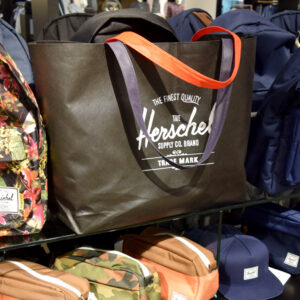
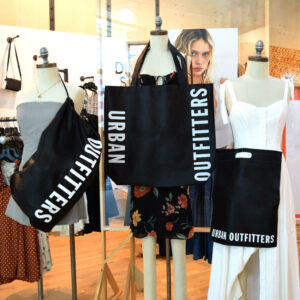
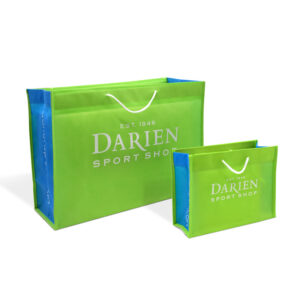
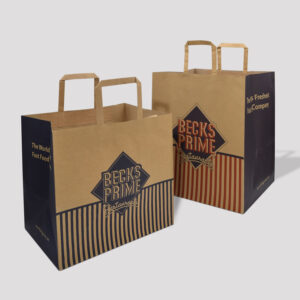
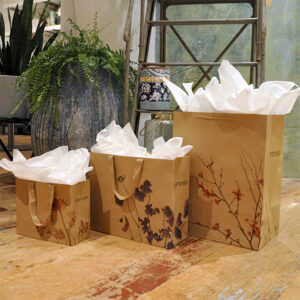
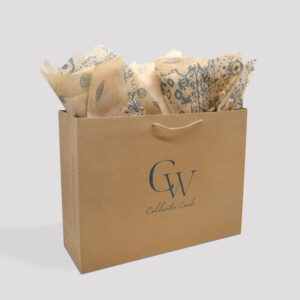
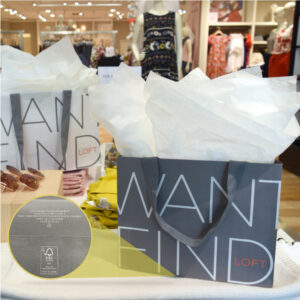
It’s important to minimize your carbon footprint when designing items for your packaging collection. When creating eco-friendly packaging, it’s important to consider your materials. Many packaging items are made recyclable and out of recyclable materials. We love to work with customers to create shopping bags that are compliant with bag ban laws. Not only are they eco-friendly, but they are automatically in compliance with laws across the country.
Creating your shopping bags out of pre–consumer or post–consumer waste will keep your packaging in compliance with regional bag laws. But, it will have a huge impact on your global carbon footprint. By making your bags with 40% or more post–consumer waste, you can save tons of waste. This type of waste would normally be going into landfills. However, there is a difference between pre-consumer and post–consumer waste. Regarding this, it is important to be able to distinguish between the two.
When we create our shopping bags out of pre–consumer or post–consumer waste, we make sure to work with the greenest factories available. There are plenty of “green” factories that produce minimal waste. Our factories use scraps from previous projects. In the construction and recycling of these materials, our carbon footprint is lower.
Pre-Consumer and Post–Consumer Waste
Pre-consumer waste is the reintroduction of scrap materials back into the manufacturing process. For example: When you create a shopping bag, there are scraps left over. Whether paper or reusable, factories incorporate these scraps into something new. This process eliminates any type of left over waste. When there is extra scrap material, they are considered pre-consumer waste.
On the other hand, post–consumer waste is a little different. Post-consumer waste materials are eligible for recycling after use. At the end of its lifespan, post-consumer waste is normally left for disposal for the recycling process. After the recycling process, post-consumer waste passes through the hands of the final consumer.
In the case of paper, pre-consumer waste would be an item – like a shopping bag. This item was created, but never used. However, Pre-consumer waste material can sometimes be hard to have in large enough amounts. At times, creating large quantities may be difficult due to scrap supply. But there is the availability to make sure of having a percentage of pre-consumer waste. If you’re looking to make your bags as eco-friendly as possible, using pre-consumer waste is the perfect option.
Post-consumer waste, on the other hand is when materials to create a new shopping bag has already been put to use and put through the recycling process. Therefore, new packaging is made from the post-consumer waste. Pre-consumer and post-consumer waste can be left over from all types of materials. From reusable to paper. Considering GSM and color of materials, we can use up to 60% of consumer waste to create new packaging.
Polypropylene Non-Woven
One material that is easily recyclable and creates new types of packaging is Polypropylene non–woven or PPNW. Virgin raw materials normally make up the pp non-woven material. However, black PPNW is one of the easiest materials to create from recyclable pre–consumer waste.
Many brands and companies tend to gravitate towards polypropylene non-woven because it is: inexpensive, strong and durable. The material itself is soft and washable. Custom dying and printing is available for customizing your ppnw bag. PPNW can easily fold, making shipping and storing easy. This material is so versatile that up to 60% PCW can make up one bag.
When it comes to pp non-woven, we are always trying to minimize our carbon footprint. A big way to do so is to work with our customers and factories. We love to work with them to create reusable and recyclable packaging. As a bonus, you can easily repurpose ppnw shopping bags. Or, if you wish to dispose of them, they are recyclable through the “PP Sack Recycling Process”. This process recycles and repurposes the pp material.
Papers With PCW Content
Similar to reusable materials, another eco-friendly component in creating environmentally friendly shopping bags is paper. Papers can be made with a percentage of pre-consumer or post-consumer waste. When designing a paper shopping bag, it is important to consider the type of materials for the project. There is a variety to choose from: bleach kraft, brown kraft, recyclable, and paper materials with post-consumer waste.
The materials you use may have an influence from bag ban laws in your city. As bag bans spread nationwide, the standard for a paper shopping bag to be compliant is 40% pcw. Constructing shopping bags with a certain percentage of post-consumer waste is mandatory. Most rules may vary from region to region.
If you are in a bag ban area, it’s important to avoid treatments like lamination and less eco-friendly papers. Using environmentally friendly papers such as brown kraft or recyclable paper will significantly reduce your impact on the environment. When you avoid lamination, our bags become recyclable. Although, some bags require the removal of handles or to be broken down to consider them recyclable.
Your shopping bags can have a label to signify whether the bag is recyclable or has post-consumer content. To show that a bag complies with current bag ban laws, we can help design a shopper with a message stating the percentage of pcw. When creating your bags, you can write this pcw claim to let clients know you care about the environment.
Pre-Consumer and Post-Consumer Waste
Both types of shopping bags, whether reusable or paper are great alternatives to single-use bags. Create your reusable and paper shopping bags with pre-consumer and post-consumer waste. In compliance with bag ban laws across the country, instead of using single-use poly bags, reusable or paper shopping bags are recyclable and reusable. They are also a great source of marketing and are automatically in compliance due to their reusability or pcw content.
Adding pre-consumer or post–consumer waste content to your shopping bags makes sense both economically and environmentally. Shopping bags like these are the future of packaging. Eco-friendly packaging is our Green Initiative. Contact us at Prime Line today to discuss your eco-compliant projects.



